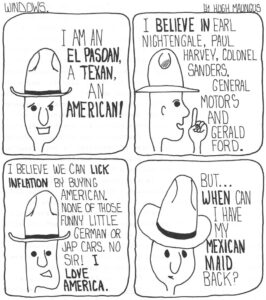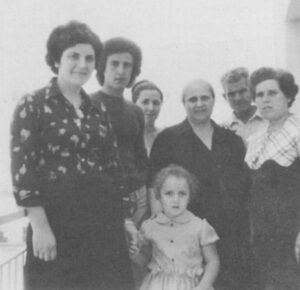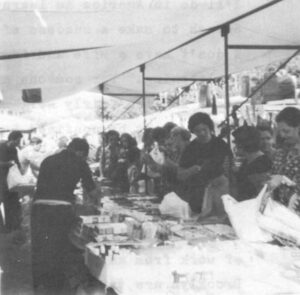Susan Jacoby
- 1974

Fellowship Title:
- The New Americans: Immigration into the U.S.
Fellowship Year:
- 1974

Immigration and the News Media: A Journalistic Failure
At the beginning of 1974, I received an Alicia Patterson fellowship to study recent immigrants to the United States and their relationship to the rest of American society. At the time, there was little public awareness of the continuing importance of immigration in American life; when Americans thought about immigration at all, they usually regarded it as a historical phenomenon that ended several generations ago. Within the space of a year, the anonymous immigrant has been transformed into a major object of news media concern: the “illegal alien,” The press still devotes scant attention to more than 400,000 immigrants who enter the United States legally each year, but the illegals are appearing in newspapers, magazines and television specials from coast to coast. There have been some outstanding exceptions, but most news coverage of illegal immigration has demonstrated the continuing inability and/or unwillingness of the American press to apply sophisticated investigative reporting techniques to complex social issues. If the news media had treated Watergate with the same naiveté as illegal immigration, Richard M. Nixon would still
Legal and Illegal Immigrants: Where do you Draw the Line?
SAN ANTONIO, Texas — St. Timothy’s is one of the many Roman Catholic churches serving the barrios of a city almost evenly divided between Anglos and residents of Mexican descent. Some of the parishioners are second-, third- and fourth-generation Mexican-American citizens, while others are more recent immigrants who have arrived in the United States by both legal and illegal routes. The church, unlike most institutional, is not interested in an immigrant’s documents. When I arrived for an appointment at a nearby office that offers a variety of social services to neighborhood residents, my light blonde hair marked me as an Anglo stranger. A young woman standing at the building entrance quickly averted her head, gathered up a child in her arms and walked away. Who knew what I wanted? Could I be an unexpected and unwelcome visitor from the U.S. Immigration and Naturalization Service? “It is a terribly sad thing to be considered an illegal person,” said Jesus Zapata, a community worker who noticed the woman’s reaction. “You are frightened to make a friend, because
Immigrants: Roots (Part III)
The Making of a New Immigrant Family
BROOKLYN, N.Y. — It in a humid ninety-degree evening in August, and the vegetable vendor who works the Carroll Street subway station has decided to go home early. His cucumbers are wilted and his horse is tired. The old man and his horse-drawn vegetable cart are fixtures in a neighborhood that encompasses both the descendants of Italian immigrants who arrived in steerage at the turn of the century and now immigrants who step off planes at Kennedy Airport each week. Around the corner in Carroll Park, old men who left Italy sore than half a century ago are playing bocce. Their grandchildren occasionally hang around and watch the old game, but most of them play baseball or basketball on a school playground across the street. Women who have been sitting in pairs on benches begin to collect their children as twilight deepens. Teenage boys and young men head for the Cafe del Sud on Court Street; it could be a cafe in any small Italian town where men meet to drink coffee, gossip and ogle

Immigrants: Roots (Part II)
The Making of a New Immigrant Family
BROOKLYN, N.Y. — Natale and Rosa Maria DeCarolis, both in their mid-forties, uprooted their family two years ago to immigrate to the United States. Ton years before, they had left their native Mola di Bari for an industrial town north of Genoa. They finally decided to emigrate from Italy in hopes of obtaining a higher education for their three children — nineteen-year-old Mario, eighteen-year-old Caterina and ten-year-old Franco. Mario and Caterina, who spoke no English when they arrived in 1972, are already fulfilling the family dream at the City University of New York. The DeCarolises are new immigrants, but they are the products of a long immigrant tradition. MOLA DI BARI, Italy — Signora Columba DeLiso has a house and a lifetime of memories in Mola, but her three children live in Brooklyn. Rosa Maria DeCarolis in her only daughter. “I grew up in an age when mothers kept the children — especially the daughters — very close to home,” says Signora DeLiso. “But I am not surprised that my children have ended up in

Immigrants: Roots (Part I)
Walking the Piazza in Mola di Bari
MOLA DI BARI, Italy — In this small town on the Adriatic Sea, the main form of recreation for young people is embodied in the phrase passeggiare la piazza — to take a walk in the piazza. Every evening, young men and women come to the town square to enjoy one of the few parentally sanctioned ways of meeting one another. Older men and women come to greet their friends and to keep an eye on what their own and other people’s children are doing. The passeggiata — an old institution with counterparts in most Mediterranean lands — used to be reserved for holidays but became a nightly occasion in the more relaxed social atmosphere that developed after World War Il. It serves both as a link with the past and as a concession to the present by recognizing that young people have the right to choose their own mates, while keeping most of the selection process in the public eye. But the passeggiata also symbolizes many of the harsher economic and social realities that
